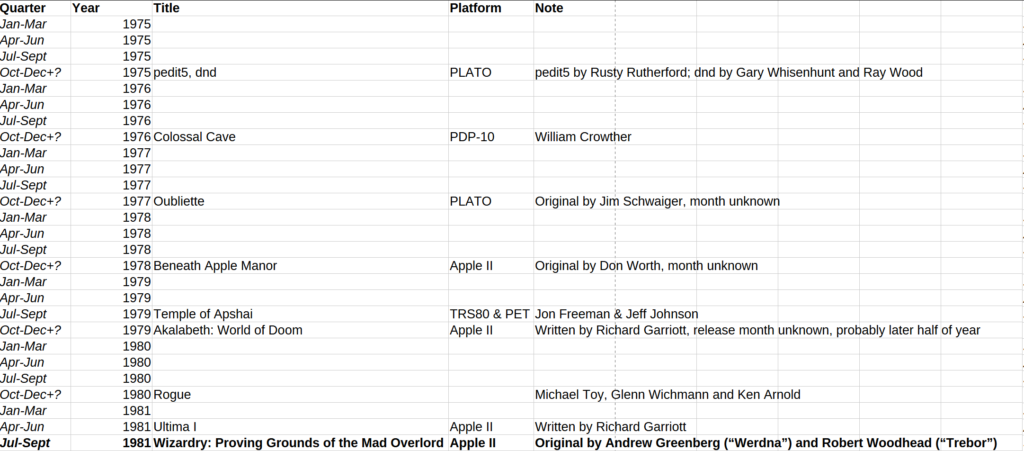Once upon a time, there was Wizardry, and nothing else. Welllll-l-l… almost nothing else. Here’s a makeshift timeline of CRPGs and CRPG-like released leading up to the original Wizardry: Proving Grounds of the Mad Overlord.

Don’t be fooled by this chart, where Wizardry happens to appear at the end. Most of these games were not widely available. Anything for a PDP or PLATO would only have been playable by a select few. Apshai and Ultima I were more widely available than their predecessors, but Wizardry was substantially deeper than either of them, and wasn’t surpassed for a while. For a time, it was the benchmark in the field, and inspired its own substantial subgenre, which we’ve heard called blobbers in the past. (Set Side B on blobbers previously, including an extensive list of them.)
Blobbers get their name because a whole RPG adventuring party is considered to exist filling one space in a first-person view of a dungeon grid, but it’s not really a great name because the defining characteristic of this sort of game isn’t the unity of the party but the view of the maze. Creating a first person maze of this type was a popular early graphical trick, because it was easy to program, and could be drawn on a tile-based display or possibly even a terminal. Blobbers continued to rule the roost for first-person games until the foundation of the first person shooters with id Software’s Catacomb-3D and Wolfenstein 3D, and more atmospheric 3D CRPGs like Origin’s Ultima Underworld.
Video and computer games are a field terribly unkind to their legacy. You might point to Mario, Sonic, Pac-Man and such as examples of games where decades-old originals are still known and played, but numerically speaking they are greatly outnumbered by the lost and nearly-forgotten. Games that used to be well known among all game-playing computer users are now mere footnotes, due to their companies going under, or their IPs being owned by uncaring megacorps interested only in milking their very most profitable properties YES I’M TALKING ABOUT ELECTRONIC ARTS. Ahem.
Wizardry is one of the foremost examples of this. For a while it was the best-selling computer RPG around, and its sequels did well for a long while. Wizardry VII was released in 1992, but then its successor Wizardry 8, a landmark title that finally brought the series into true 3D, took nine years to finish, and was sadly released right around the time of the demise of publisher Sir-Tech, although their Canadian branch lasted until 2oo3.
After Sir-Tech Software shut its doors, the series’ torch was held aloft for a long while by a succession of Japanese developers, beginning with ASCII Entertainment. Many of these games are still extremely obscure to the Western world, which seems odd considering how connected we’ve all become. We don’t even know if Robert Woodhead had anything to do with the first of the Japanese games, Wizardry Gaiden. The Japanese Wizardly line is all over the place aesthetically, but in play sticks by the formula of the very earliest games: spell ranks, permadeath, and tricky mazes. Despite being made for systems as varied as the Super Famicom and the PlayStation II, in gameplay they’re all of the Apple II orchard with limited additions. Despite being much that we don’t know, we still know a fair bit, due to an amazing 2020 article on the blog of the CRPG Addict written by “Alex,” with a great comments thread, that all deserves to be etched in stone and set forever on a monument in the middle of the town square of Llylgamyn.
It is more than a mere shame that all of these games remain effectively locked off from the country of Wizardry’s origin. An aging legion of players from the days of the Apple II has no idea that, in a land half a world away, 35 more Wizardry games, with gameplay with a clear recognizable link to the originals, were made and enjoyed. Maybe some day those games will be made more accessible to English-speaking audiences, the ones that aren’t now lost forever, at least.

I’ve said all of this, and I haven’t even gotten to what I had originally intended to be the subject of the piece, the terrific remake of Proving Grounds of the Mad Overlord made by Digital Eclipse. Perhaps it’s best to hold off on that for a couple of days. Soon!
P.S. If anyone knows of easy-to-learn open source timeline making software, I’d greatly like to know of it, or even if there’s a good Excel or (preferably) LibreOffice add-on for that purpose.
